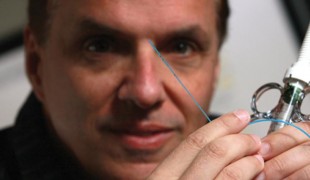- 6509
- 362
- 5
- 3
- 0
- Help Ukraine
About the solution
In 1993, he was riding his motorbike when he had an accident. When he was at the hospital, he had a CT scan that uncovered a brain tumor. The neurosurgeon said he needed an operation immediately as it might be malignant. Because of the tumor's position in the part of the brain that controls movement and conscious thought, Yaron knew he would probably survive the surgery but would suffer some cognitive dysfunction, develop epilepsy and could see half of his body become paralyzed.
The operation was a success, and after six months' recuperation, Yaron says he "felt an amazing victory and had no symptoms." The picture soon clouded, however, when he discovered 18 months later that the tumor was still there. When he returned to New York for another operation, the doctor told him no technology existed to remove such a deep-seated cancer. He was told to wait five years, and if he was lucky, someone would invent the technology.
What was needed was a smaller camera or scope that would allow the surgeon to see inside the brain in three dimensions and successfully remove the tumor. "What happens if no one invents this stupid camera? I felt so helpless. Even the best surgeon in the world couldn't save me. I had no hope. Trust me, it is not fun to live that way," Yaron said.
The will to live, combined with his innate curiosity, propelled Yaron to return to the library, this time to learn about visual perception, the way the brain is built, camera technology and stereoscopic vision. After two years of research, he thought he had guessed what the problem was. "I invented a solution. It was a single miniature silicon chip that could provide the proper image-processing algorithms."
Yaron says it was not actually his invention; he simply mimicked the way an insect eye works. Having left his job, Yaron filed some patents, scraped together $100,000, hired a physics Ph.D. and built a prototype to show the skeptics that his solution would work.
The solution came too early, according to Yaron, who said the world wasn't ready for 3D in 2008 and only with the release of the film "Avatar" a year later did the world embrace and accept 3D. "The technology works and saves thousands of lives globally now," he said.
More info: http://www.visionsense.com/
Adapted from: http://bit.ly/2fXPYj8
What about you, do you have any solutions? Please share them with the Patient Innovation community!
https://www.youtube.com/watch?v=YQqJ2ZuSMKg
This solution shall not include mention to the use of drugs, chemicals or biologicals (including food); invasive devices; offensive, commercial or inherently dangerous content. This solution was not medically validated. Proceed with caution! If you have any doubts, please consult with a health professional.
DISCLAIMER: This story was written by someone who is not the author of the solution, therefore please be advised that, although it was written with the utmost respect for the innovation and the innovator, there can be some incorrect statements. If you find any errors please contact the patient Innovation team via info@patient-innovation.com



 en
en